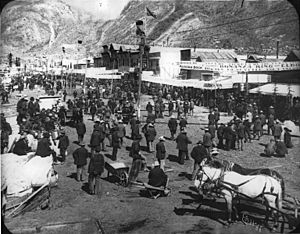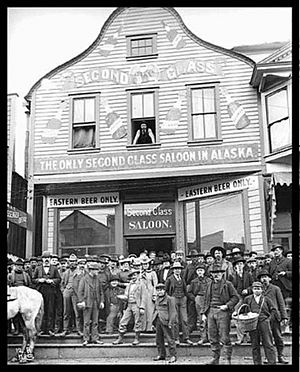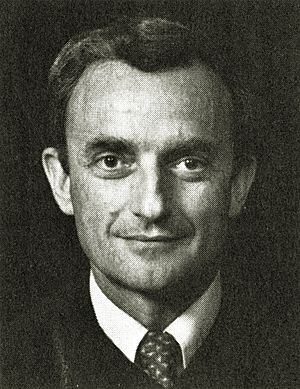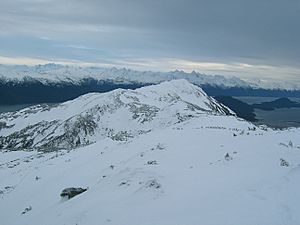History of the Jews in Alaska facts for kids
The history of Jewish people in Alaska began even before the United States bought Alaska in 1867. Jewish fur traders from the Russian Empire lived there sometimes. A Jewish community has existed in Alaska since the 1880s.
The Klondike Gold Rush and Nome Gold Rush attracted many Jewish people to Alaska. They came to find gold or start businesses. This led to the first organized Jewish communities in the area. Later, during the time of Nazism, the U.S. government thought about helping Jewish refugees settle in Alaska. However, this idea was not supported and never happened.
Jewish people in Alaska have played a big part in business and politics. They have been mayors, judges, senators, and even governors. Today, Jewish people live in all the main cities across Alaska.
Contents
Early Jewish Life in Alaska
In the 1850s and 1860s, Alaska was a Russian colony. Jewish fur traders from Russia had business ties with Jewish communities in San Francisco. After the United States bought Alaska from Russia in 1867, some Jewish miners and merchants from San Francisco moved north.
At the official ceremony where Alaska became part of the U.S., a Jewish soldier named Benjamin Levi helped lower the Russian flag. He then raised the American flag. The next year, two Jewish men from San Francisco, Louis Sloss and Lewis Gerstle, helped start the Alaska Commercial Company.
In 1885, the first permanent Jewish settlers, Robert Gottstein and his wife, moved to Juneau, Alaska. Their son Jacob later settled in Anchorage, Alaska. Jacob started a very successful business. His wife, Anna, was a teacher and helped create Alaska's first Parent-Teacher Association.
Gold Rush Days
When the Klondike Gold Rush began in 1897, many Jewish people joined the search for gold. At one point, about 200 Jewish people lived in Dawson City. This is likely where the first Jewish religious services in the territory took place. Sid Grauman, who later founded Grauman's Chinese Theatre, lived in Dawson with his family during this time. A Jewish cemetery called Bet Chaim was created in Dawson during the rush and was rediscovered in 1998.
Jewish people also went to the Nome Gold Rush, which started in 1899. In 1900, Sam Bayles brought the first Torah (a holy Jewish scroll) to Alaska. Max Hirschberg, who was 19, biked 1,100 miles from Dawson to Nome in ten weeks. He did this despite the freezing cold and bad weather.
The famous lawman Wyatt Earp and his Jewish wife, Josephine, ran a successful saloon called The Dexter in Nome. They made a lot of money during the gold rush. In 1900, about 60 Jewish people attended Rosh Hashanah (Jewish New Year) services in Nome.
Fairbanks Community
The Jewish community in Fairbanks, Alaska was first organized by Robert Bloom in 1904. Between 1904 and 1910, during the Fairbanks Gold Rush, there were enough Jewish people to have regular services for the High Holy Days. In 1908, the Fairbanks community officially formed Congregation Bikkur Cholim. The Clay Street cemetery still has a Jewish section from this time.
After the gold rush, only a few Jewish people remained in Fairbanks, including Robert Bloom and his wife, Jessie. Jessie, who came from Ireland in 1912, started the first Girl Scouts chapter in Alaska in 1925. Robert Bloom helped establish Fort Wainwright and was a founder of the University of Alaska. During World War II, many Jewish soldiers came to Fairbanks. The Blooms welcomed them into their home.
Leopold David became the first mayor of Anchorage in 1920.
From the 1940s to the 2000s
In 1939, Ernest Gruening became the governor of the Alaska Territory. He served until 1953. He is often called "the father of Alaskan statehood" because he worked hard for Alaska to become a state. When Alaska became a state, he became its first senator in 1958.
In 1906, Abe Spring, a Jewish immigrant from Russia living in Fairbanks, suggested that Jewish refugees from Russia could settle in Alaska. This idea was not taken seriously by the United States Congress for many years.
Over 30 years later, during the Nazi persecution of Jewish people in Germany, a similar idea came up. After Kristallnacht (a violent attack on Jewish people in Germany), the U.S. Secretary of the Interior, Harold L. Ickes, suggested a Jewish settlement in Alaska. The goal was to help build up Alaska's industry and allow more German Jewish refugees into the country. However, the people of Alaska did not like the idea of "aliens" settling there. The plan never happened. This topic gained new interest in 2007 with the book The Yiddish Policemen's Union.
Jewish Military Personnel
During World War II, many Jewish soldiers were stationed in Alaska. Elmendorf Air Force Base near Anchorage had a Jewish chaplain from the 1940s to the 1980s. These chaplains changed every two years and came from different Jewish movements: Reform, Conservative, and Orthodox.
In 1974, Alaska's only mikveh (a Jewish ritual bath) was built at Elmendorf Air Force Base. It was for the chaplain's wife and the wider Jewish community. These chaplains often served all Jewish people in Alaska. They traveled to cities and small towns for events like a bar mitzvah. From the 1940s through the 1970s, there were more Jewish military personnel than Jewish civilians in Alaska.
Community Growth
Zachariah "Zach" J. Loussac was the mayor of Anchorage from 1948 to 1951. He was a Jewish immigrant from Russia. After selling his business, he became a generous giver to the community. He helped build Anchorage's first library. The main branch of the Anchorage public library is still named in his honor.
The largest Jewish congregation in Alaska, Beth Sholom in Anchorage, was formed in 1958. It became part of the Reform movement in 1960. Their first small synagogue was built in 1964. As more people joined, a new, larger synagogue was opened in 1988.
Jay Rabinowitz was a Justice on the Alaska Supreme Court for over thirty years (1965-1997). He was the Chief Justice for 12 of those years. He wrote many important legal opinions that helped shape Alaska's laws. The Rabinowitz Courthouse in Fairbanks is named after him.
Avrum Gross served as the Alaska Attorney General from 1974 to 1980.
The Jewish Congregation of Fairbanks was officially formed in 1980. In 1992, they bought a synagogue building and became Congregation Or HaTzafon. In 1997, they officially joined the Reform movement. It might be the northernmost permanent synagogue in the world.
In 1991, Chabad representatives, Yosef "Yossi" and Esty Greenberg, arrived in Alaska. They set up a Chabad center in Anchorage, starting prayer services and a preschool.
In the 1990s, the popular TV show Northern Exposure featured a young Jewish doctor moving from New York to a small, fictional town in Alaska.
A study done between 1994 and 1999 found that Jewish people in Alaska were often more involved in their Jewish community than Jewish Americans in the "Lower 48" states.
In 2005, Congregation Sukkat Shalom in Juneau opened its first synagogue. Before that, they met in members' homes.
Jewish Life in the 21st Century
Today, about 6,000 Jewish people live in Alaska. Most live in Anchorage, Fairbanks, and Juneau. Some also live in smaller places like Sitka and Ketchikan. The Jewish community in Alaska sometimes calls itself the "Frozen Chosen."
There are currently two permanent rabbis in the state, both in Anchorage. They are Michael Oblath of Congregation Beth Sholom and Yossi Greenberg of Chabad.
Anchorage mayor Ethan Berkowitz, who took office in 2015, is the third Jewish person to serve in this role. Other Jewish people active in Alaskan politics include Democrat Les Gara and Republican Jay Ramras.
In 2013, Chabad's Alaska center, led by Yossi and Esty Greenberg, opened a new campus in Anchorage. It serves Jewish people in Alaska and visitors. The state's only mikveh is also on this campus. The Chabad center also has a preschool and the Alaska Jewish Museum. The museum shows how Jewish people have impacted Alaska and explores Jewish history and culture.
In 2016, Captain Michael Bram became the first Jewish chaplain at Joint Base Elmendorf–Richardson in 25 years.
Places Named for Jewish People
At least four mountains in Alaska are named after Jewish individuals:
- Mount Ripinski is named after Solomon Ripinski.
- Mount Neuberger is named after Richard L. Neuberger.
- Mount Applebaum is named after Samuel Applebaum.
- Mount Gruening is named for Ernest Gruening.
Additionally, the Gerstle River was named for Lewis Gerstle.






